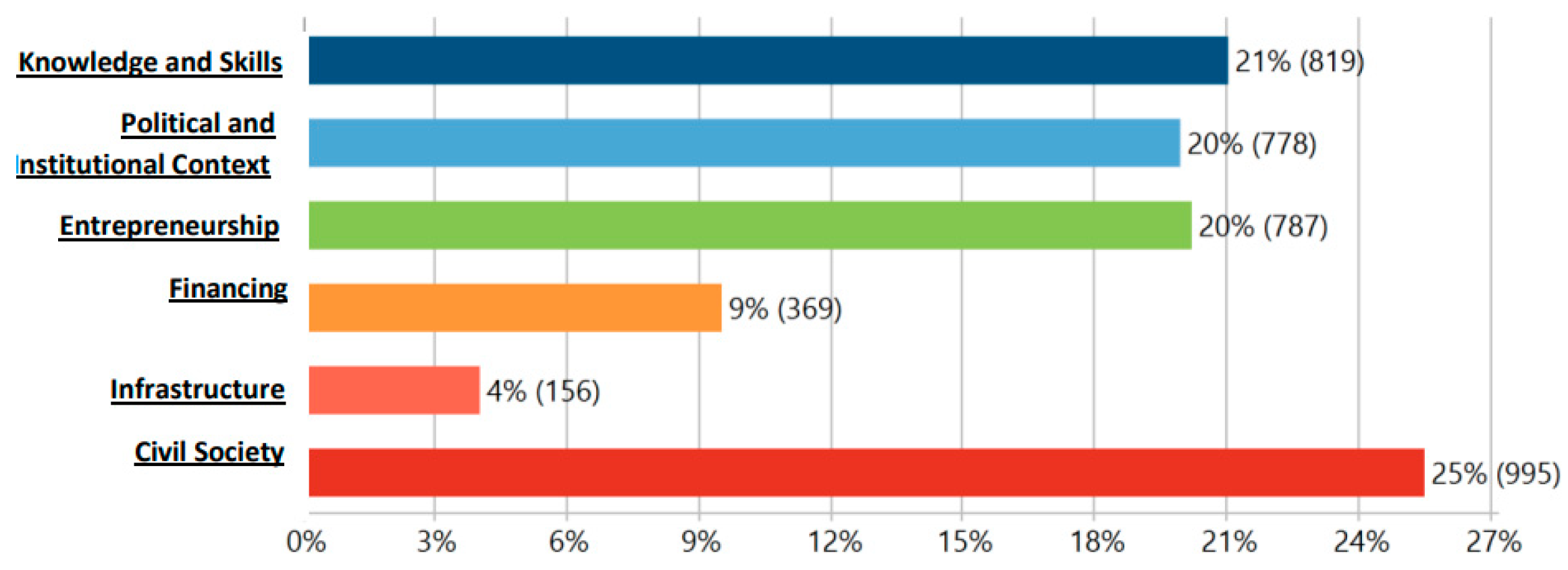Empowering Rural Communities on Rural Pact Implementation: A Human–Ecological Perspective on Social Innovation and Rural Young Entrepreneurship †
Abstract
1. Introduction
2. Materials and Methods
3. Results and Discussion
4. Main Considerations and Future Actions
Author Contributions
Funding
Institutional Review Board Statement
Informed Consent Statement
Data Availability Statement
Conflicts of Interest
References
- Dyball, R. A brief history of human ecology within the Ecological Society of America and speculation on future direction. Hum. Ecol. Rev. 2017, 23, 7–16. [Google Scholar] [CrossRef]
- Organization for Economic Co-Operation and Development (OECD). Assessing the Framework Conditions for Social Innovation in Rural Areas. OECD Local Econ. Employment Dev. (LEED) Pap. OECD Publishing, 2024. Available online: https://www.oecd.org/en/publications/assessing-the-framework-conditions-for-social-innovation-in-rural-areas_74367d76-en.html (accessed on 20 May 2024).
- Eichler, G.M.; Schwarz, E.J. What sustainable development goals do social innovations address? A systematic review and content analysis of social innovation literature. Sustainability 2019, 11, 522. [Google Scholar] [CrossRef]
- Moulaert, F. Social Innovation: Institutionally Embedded, Territorially (Re)Produced. In Social Innovation and Territorial Development; MacCallum, D., Moulaert, F., Hillier, J., Vicari Haddock, S., Eds.; Routledge: New York, NY, USA, 2016; eBook; pp. 27–40. ISBN 9781315609478. [Google Scholar]
- Nordberg, K. Spatial justice and local capability in rural areas. J. Rural Stud. 2020, 78, 47–58. [Google Scholar] [CrossRef]
- Ferrão, J. Despovoamento em áreas rurais: Entre a inevitabilidade e a capacidade de transformação. Cultivar. Cad. Anál. Prosp. 2018, 11, 13–19. [Google Scholar]
- Proietti, P.; Sulis, P.; Perpiña Castillo, C.; Lavalle, C.; Aurambout, J.P.; Batista E Silva, F.; Bosco, C.; Fioretti, C.; Guzzo, F.; Jacobs, C.; et al. New Perspectives on Territorial Disparities; EUR 31025 EN; Publications Office of the European Union: Luxembourg, 2022; ISBN 978-92-76-49485-0. JRC126033. [Google Scholar] [CrossRef]
- Huntjens, P. Towards a Natural Social Contract: Transformative Social-Ecological Innovation for a Sustainable, Healthy and Just Society; Springer Nature: Berlin/Heidelberg, Germany, 2021; p. 205. [Google Scholar] [CrossRef]
- European Innovation Scoreboards (EIS) Project. How to Measure Social Innovation. Exploratory Report. European Commission. 2021. Available online: https://ec.europa.eu/docsroom/documents/45665/attachments/1/translations/en/renditions/native (accessed on 13 April 2021).
- Thompson, J. A Guide to Abductive Thematic Analysis. Qual. Rep. 2022, 27, 1410–1421. [Google Scholar] [CrossRef]
- Vila-Henninger, L.; Dupuy, C.; Van Ingelgom, V.; Caprioli, M.; Teuber, F.; Pennetreau, D.; Bussi, M.; Le Gall, C. Abductive coding: Theory building and qualitative (re) analysis. Sociol. Methods Res. 2024, 53, 968–1001. [Google Scholar] [CrossRef]
- Slee, B.; Lukesch, R.; Ravazzoli, E. Social innovation: The promise and the reality in marginalised rural areas in Europe. World 2022, 3, 237–259. [Google Scholar] [CrossRef]
- Ferrão, J. Animar localmente prefigurações de futuros desejados. Da inovação social à transformação societal. In Entre Urgências e Utopia: Múltiplas Escalas da ação: Que Mundo Estamos a Construir? Consequência Editora: Rio de Janeiro, Brasil, 2023; pp. 37–62. [Google Scholar]
- Westlund, H.; Borsekova, K. Rural problems, policies and possibilities in a post-urban world. Reg. Sci. Policy Pract. 2023, 15, 717–728. [Google Scholar] [CrossRef]
- Mahon, M.; Woods, M.; Farrell, M.; Jones, R.; Goodwin-Hawkins, B. A spatial justice perspective on EU rural sustainability as territorial cohesion. Sociol. Ruralis 2023, 63, 683–702. [Google Scholar] [CrossRef]

Disclaimer/Publisher’s Note: The statements, opinions and data contained in all publications are solely those of the individual author(s) and contributor(s) and not of MDPI and/or the editor(s). MDPI and/or the editor(s) disclaim responsibility for any injury to people or property resulting from any ideas, methods, instructions or products referred to in the content. |
© 2025 by the authors. Licensee MDPI, Basel, Switzerland. This article is an open access article distributed under the terms and conditions of the Creative Commons Attribution (CC BY) license (https://creativecommons.org/licenses/by/4.0/).
Share and Cite
Parreira, M.J.; Pires, I. Empowering Rural Communities on Rural Pact Implementation: A Human–Ecological Perspective on Social Innovation and Rural Young Entrepreneurship. Proceedings 2025, 113, 2. https://doi.org/10.3390/proceedings2025113002
Parreira MJ, Pires I. Empowering Rural Communities on Rural Pact Implementation: A Human–Ecological Perspective on Social Innovation and Rural Young Entrepreneurship. Proceedings. 2025; 113(1):2. https://doi.org/10.3390/proceedings2025113002
Chicago/Turabian StyleParreira, Maria João, and Iva Pires. 2025. "Empowering Rural Communities on Rural Pact Implementation: A Human–Ecological Perspective on Social Innovation and Rural Young Entrepreneurship" Proceedings 113, no. 1: 2. https://doi.org/10.3390/proceedings2025113002
APA StyleParreira, M. J., & Pires, I. (2025). Empowering Rural Communities on Rural Pact Implementation: A Human–Ecological Perspective on Social Innovation and Rural Young Entrepreneurship. Proceedings, 113(1), 2. https://doi.org/10.3390/proceedings2025113002





